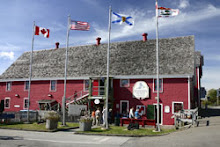
Hello Everyone,
Now-a-days the bright red buildings of the Fisheries Museum of the Atlantic are so much a part of the Lunenburg waterfront that it is difficult to imagine the structures that dotted our shoreline in years past.
Memories and old photographs help to fill in the gaps. Museums depend greatly on oral histories and reminiscences from older generations. Photographic images capture moments in time and help to flesh out the stories.
When I was a child, long before I began work at the Fisheries Museum of the Atlantic, my father told me stories of the fishing schooners, the crews, the captains and the Lunenburg waterfront. I was able to see, through his words, images of things that were no longer in evidence.
Fish flakes were part of that rich heritage.
Does the expression bring to mind tins of flaked tuna or salmon? That’s not what we mean, when we speak of fish flakes.
Fish flakes were roughly hewn structures of wooden poles and branches, located near the shoreline. Salt fish were carefully placed on the flakes and dried in the sun. The people who manned the flakes were sometimes called "fish makers". (The image of the fish makers, at the top of this blog, dates to the 16th century, when European fishermen dried their fish at Newfoundland.)
When the schooners returned home with their freshly salted catch of fish, the fish still needed to be dried, to help in their preservation. Men, women and children all helped in the careful drying of the fish. They made certain that the fish were not scorched by the sun, nor were they exposed to the rain. It meant that for several weeks, the flakes had to be constantly tended.
The time on the fish flakes was a critical time in the fishery. Fish that were damaged during the drying process did not get a good price when the fish companies sold the finished product.
Wishing you Smooth Sailing,
Heather


No comments:
Post a Comment